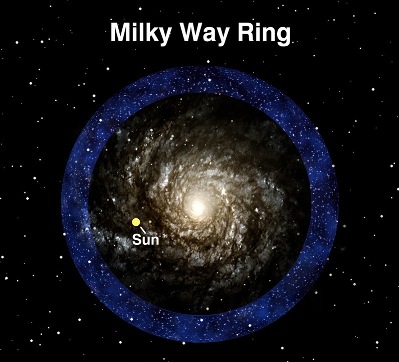2 billion yr old galactic impact has left Milky Way ringing
 Canberra, Feb 19 : In a new research, an international team of astronomers has explained that a small galaxy colliding with our own almost two billion years ago has caused the Milky Way to vibrate, or `ring', that is still being felt.
Canberra, Feb 19 : In a new research, an international team of astronomers has explained that a small galaxy colliding with our own almost two billion years ago has caused the Milky Way to vibrate, or `ring', that is still being felt.
"Astronomers have known for almost a decade that the Milky Way is ringing," researcher Professor Ken Freeman of the Research School of Astronomy and Astrophysics at the Australian National University, told ABC News.
They have suspected the ringing was caused by a bar-like structure in the centre of the galaxy.
"In the centre of our galaxy is a bar-like structure that is quite massive," said Freeman. "Because it's not round, its gravitational field is not round, so you get a certain kind of resonance between the bar and the stars that are moving," he added.
But, Freeman and colleagues have now shown, through mathematical modeling, that a major cause of the galactic ringing was a collision by a small galaxy that occurred
1.9 billion years ago.
"Like a stone dropping into a pond, the collision resulted in vibrations that set up a resonance in the Milky Way and caused stars to group into clusters," said Freeman.
Freeman said that clusters of stars can occur during star formation. They also can form when a small galaxy is sucked into our own, broken up into pieces and its debris spread around.
He said it is important to "weed out" the clusters that form as a result of the ringing, in order to determine the formation of the Milky Way.
"It's pretty important to work out which one of these is which, if we want to try and trace what has happened in the galaxy over the years," said Freeman.
The new model shows a series of dense star streams, which are similar to the distribution of stars observed in our solar neighbourhood.
According to Freeman, the model allowed him and his colleagues to turn back the clock and determine when the galaxy that helped set off the ringing collided with the Milky Way.
He says that although it is difficult to determine the exact size of the smaller galaxy, he estimates that it would have been one-hundredth the size of the Milky Way.
Freeman is eager to collect more data to further test the model and is awaiting the launch of a European satellite named Gaia, which is scheduled to launch in 2015, which is expected to produce a massive increase in data. (ANI)